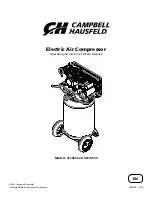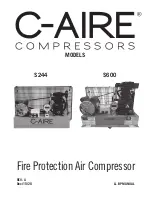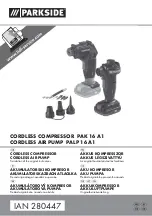
3
IMPORTANT SAFETY INSTRUCTIONS
This compressor is designed for tyre inflation, the
operation of pneumatic tools, spray painting and
spraying non-corrosive cleaning agents. Do not use
this compressor for filling cylinders for breathing or
diving apparatus. Compressed air from this
compressor must not be used for pharmaceutical,
food or health applications.
When spraying flammable liquids such as paint and
non-corrosive cleaning agents the distance
between the compressor and the work area must
be a minimum of 4 metres. When spraying liquids
always wear a suitable face mask designed for
protection against the liquid being sprayed. Always
wear approved safety glasses.
Do not attempt to modify the compressor or any
pneumatic tools in any way. Use only accessories
and pneumatic tools that are rated for the capacity
of the compressor. Never leave the compressor
pressurised.
Always transport the compressor by lifting or
pulling it with the appropriate grips or handles.
Do not insert your fingers or other objects inside
the motor housing to avoid physical damage or
damage to the compressor.
If any part of the compressor is damaged, it should
be carefully checked to determine that it will
operate correctly and perform its intended function.
Check for the alignment of parts, damage to parts,
air leaks and any other conditions that may affect
its operation. A guard or any other part that is
damaged or defective should be properly repaired
or replaced by an authorised service centre.
Defective pressure switches must be replaced prior
to further use of the compressor.
WARNING.
This compressor must be
connected to a power socket that is
safeguarded by a suitable circuit breaker
or fuse.
To reduce the risk of electric shock, do not expose
to rain. Store indoors.
Inspect tanks yearly for rust, pin holes, or other
imperfections that could cause it to become unsafe.
Never weld or drill holes in the air tanks.
Only use recommended parts. To avoid the risk of
bursting, only hoses with a rated pressure of 8 bar,
or more should be used. Never attempt to repair
faulty hoses.
Avoid kinking or trapping the air hose. Always
replace faulty hoses - never attempt a repair if a
leak is detected.
Make sure the hose is free of obstructions or
snags. Entangled or snarled hoses can cause loss
of balance or footing and may become damaged.
Do not operate this air compressor if it does not
contain a legible warning label.
Always disconnect the air supply and power supply
before making adjustments, servicing a product, or
when a product is not in use.
Make sure your extension cord is in good condition.
When using an extension cord, be sure to use one
heavy enough to carry the current your product will
draw. A wire gauge size (A.W.G.) of at least 14 is
recommended for an extension cord 25 feet (7.6m)
or less in length. A cord exceeding 50 feet (15.2m)
is not recommended. If in doubt, use the next
heavier gauge. The smaller the gauge number, the
heavier the cord. An undersized cord will cause a
drop in line voltage resulting in loss of power and
overheating.
Never store a tool with air connected. Storing the
tool with air connected can result in unexpected
firing and possible serious personal injury.
Protect your lungs. Wear a face or dust mask if the
operation is dusty. Following this rule will reduce
the risk of serious personal injury.
Keep the motor vent clear and free from dust, wipe
regularly to maintain an adequate supply of clean
air to the air compressor.
If the power supply cord is damaged, it must be
replaced only by the manufacturer or by an
authorized service center to avoid risk.
SAVE THESE INSTRUCTIONS
1) WORK AREA
a)
Keep your work area clean and well lit.
Cluttered benches and dark areas invite
accidents. Floor must not be slippery from wax
or dust.
b)
Do not operate air compressors in explosive
atmospheres, such as in the presence of
flammable liquids, gases, or dust.
Power
tools create sparks which may ignite the dust or
fumes.


































